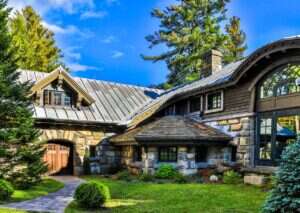
When the hustle and the bustle of the city gets too much, there’s only one place that New Yorkers turn to to get some much-needed fresh air: Upstate. We’re far from the first ones to think so. In the mid to late 1800s, families like the Rockefellers and Vanderbilts came to the areas like Lake Placid to build lavish retreats, said to have been nicknamed their own “great camps”.
While the mountainous Adirondack region has traditionally been overshadowed by the ever-popular towns like Rhinebeck or Hudson, take a quick scan across the waterfronts or between the woodlands around Lake Placid, and you’ll find many extravagant estates.
[See also: Mohonk Mountain House: Hudson Valley’s Historic Retreat]
 The property was inspired by Alpine lodges / ©Jonathan Esper
The property was inspired by Alpine lodges / ©Jonathan EsperLake Placid is perhaps best known for its role in sporting history, with the area hosting the Winter Olympics not just once or twice, but three times: in 1932, 1980 and 1972. But we have found this 70-acre estate which has forged a rich sporting past of its own.
Once owned by renowned golfer and winner of the 1941 Masters Invitational, Craig Wood, it was passed into the hands of inventor George Holley, who is credited with inventing the Holley car carburetor and keeping close relations with Thomas Edison (more on that later).
[See also: Inside San Francisco’s Second-most Expensive Property Listing]
 The developer and former owner focused on using natural materials / ©Jonathan Esper
The developer and former owner focused on using natural materials / ©Jonathan EsperUpon Holley’s passing, the estate fell into the ownership of Olympic luger-turned-property developer Joe Barile in the mid-noughties. Barile, who has since become one of the most prolific developers in the Lake Placid area, demolished the existing home and spent the years since building the five-bedroom, five-bathroom expansive estate that we see today.
Saving gold and any other precious metals for medals, this almost 15,000-sq-ft mansion is notably Alpine in its rustic charm, with Barile turning to the wonders of nature, impeccable craftsmanship and the skills of artisans to create a pastoral paradise. All the stones used on the property’s exterior were quarried on site, and artisans from the UK lived on the property for almost four years while installing the lead roof.
 Every stone used in the property was quarried on site / ©Jonathan Esper
Every stone used in the property was quarried on site / ©Jonathan EsperOf course, there are the usual signifiers of luxury – and then some. Within the property’s 70 acres of land, there is also a bowling alley, gym, wine cellar, outdoor terraces, two-family farmhouse and additional outbuildings.
Perhaps the property’s most notable feature is its hydropower plant, where a dam sits on the neighboring river and provides most of the estate’s electricity. It is said that the property’s former owner Holley, in recognizing the potential of the land, engaged the expertise of his friend Thomas Edison to construct the dam – an oil painting of Edison still hangs in the home and Barile has spoken of his plans to pass it on to the buyer.
 The property's on-site hydro dam was said to have been constructed by Thomas Edison / ©Jonathan Esper
The property's on-site hydro dam was said to have been constructed by Thomas Edison / ©Jonathan EsperIn addition to that dam, the property's 15,000-sq-ft footplan and 70 acres of land, the lucky buyer will likely go down in local history, too. If the property sells for anything close to its $28.5m asking price, it will set a record for the area’s priciest home – the current record, Braille told the Washington Post, is held by an adjacent ranch that sold for $13m in 2005.
$28.5m, nobleblackatdouglas.elliman.com
[See also: Is This Resort Town in Mexico’s Baja Peninsula the Next Los Cabos?]

 German (DE)
German (DE)  English (US)
English (US)  Spanish (ES)
Spanish (ES)  French (FR)
French (FR)  Italian (IT)
Italian (IT)  Macedonian (MK)
Macedonian (MK) 







Comments